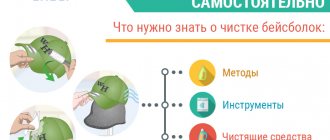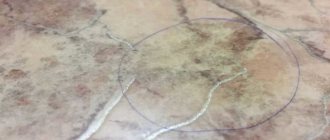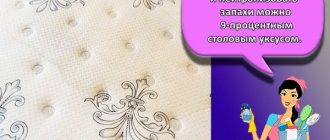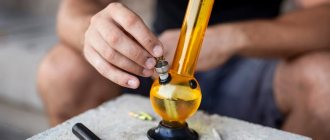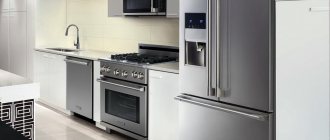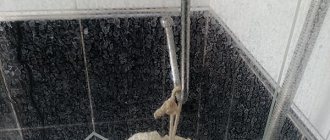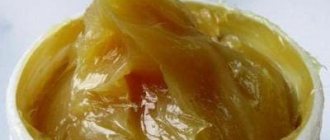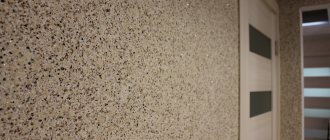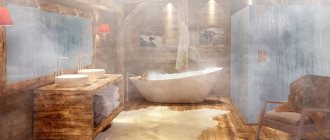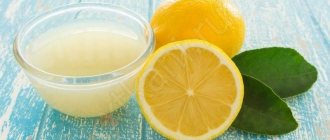Cleaning stains on linoleum: how to remove complex stains from the surface
Linoleum, like any floor covering, can develop stains over time. What to do with them? Not everyone knows how to remove stains from linoleum. The specificity of the coating is that it is important to combat dirt so as not to damage the thin decorative layer, scratch it or erase it. Plus, this flooring does not like excessive moisture and abrasive materials.
Clean and beautiful linoleum
How to remove whitewash from laminate flooring?
Laminate is a coating that, like parquet, really does not like water. Excessive moisture will negatively affect this type of coating, so you cannot use large quantities of water for washing. Although in general, this type of finishing material for finishing the floor is quite durable and reliable. But you still need to clean it carefully, otherwise you can damage the outer protective layer. And without it, the material will become susceptible to all types of mechanical and physical stress, as a result of which its service life will be dramatically reduced.
Cleaning laminate flooring should be done with great care
A vinegar solution of 1 - tbsp will help with whitewash stains on laminate flooring. l. dissolves in a 5 liter bucket of water. After this, a soft cloth (preferably microfiber) is moistened with the resulting solution and wrung out thoroughly - no liquid should flow from it. The floors are then treated with a damp cloth. The final stage is washing the laminate with plain water.
Important! The rag should be rinsed in a vinegar solution as often as possible. The cleaner it is, the easier it will be to remove dirt.
Just like parquet, laminate can be treated with vegetable oil. It is diluted in warm water in a ratio of 1:100. After treating the laminate with this composition, it is wiped with vinegar diluted in water (2 tablespoons per 5-liter bucket).
On a note! Vinegar can be replaced with citric acid.
Washing vacuum cleaner for laminate flooring
Another remedy for removing white plaque from laminate flooring is a solution of ordinary table salt. The main thing is not to dilute it in water in large quantities, otherwise stains may remain on the floor. The optimal consumption is 0.5 cups of salt per bucket of water. After treating with this composition, the floor is wiped with a clean hoe moistened with plain water.
We remove and remove contaminants
Stains on any linoleum are a problem, especially if you don’t have special products at hand. There are plenty of the latter on store shelves, and you can solve the problem of pollution simply by using such products. But for certain reasons, housewives are in no hurry to buy them, because although they will remove pollution, they can harm the residents of the house with their chemical composition.
There are many folk methods and remedies that can cope with removing stains just as well.
Note! If new contaminants appear on the coating every now and then, you need to understand why this is happening. Without knowing the reason, you can fight against windmills, because pollution will appear again and again.
Available products can help deal with various stains. This:
- Soap.
- Gasoline, turpentine.
- Napkins.
- Acetone and nail polish remover.
- Plastic spatula.
- Fine-grained sandpaper, pumice.
- Vegetable oil.
- Hydrochloric acid.
- Camphor alcohol.
- Hydrogen peroxide.
- Acetic acid.
- Potassium permanganate.
Every housewife has most of these products at home, so you don’t have to worry about what and how to remove stains from linoleum. Although it is worth learning about the methods in more detail, because some products can damage the coating irrevocably.
Any stains must be removed immediately
It is worth remembering that you need to monitor the condition of the coating regularly and immediately remove any dirt that appears, this way you will be able to avoid their penetration into the thickness of the canvas, because such defects are sometimes very difficult to deal with.
How to remove yellowness at home?
Below are the means and compositions for removing yellow spots and yellowness:
How to remove fabrics and clothes?
You can get rid of yellow stains on clothes and fabrics using such compositions as:
Vinegar with a concentration of 9% in combination with laundry soap. Vinegar is applied to the problem area, after 5 minutes sprinkled with ground soap crumbs and rubbed with an old toothbrush. Rinse the item in clean water.- Lemon acid . To prepare the solution you will need 2 teaspoons of powder and 1 glass of water. The mixture is applied to the yellowed fabric and washed after 30 minutes.
- Hydrogen peroxide . Moisten the stain with it, leave it for 15 minutes, and then wash it using powder or soap.
- Soda. It must be diluted to a liquid paste that completely covers the stain. After 30 minutes the product is washed.
- Stain removers and bleaches . Products from the Vanish Gold series have a good effect. Their average cost is 150-200 rubles. You can soak colored items for an hour, and white items for 3 hours, after which you need to start the main wash.
If the fabric is thin, then it can only be treated with gentle compounds, for example, stain remover for delicate items, or laundry soap. The water temperature should not exceed 30 degrees.
From the iron
Yellow stains on the iron must be removed immediately after they appear, as they will stain things during ironing. Means to effectively cope with the problem:
- A mixture of hydrogen peroxide and ammonia . To prepare the cleaning solution you will need 2 teaspoons of peroxide and 7 drops of ammonia. A cotton swab is soaked in the composition and the sole of a cold iron is treated with it until the stain completely disappears. For high-quality cleaning you will need to put in a lot of effort.
- Paraffin candle . It must be wrapped in cotton cloth and rubbed over the sole of the hot iron. The device must be held over a newspaper spread out so that melting paraffin does not drip onto the floor. Also, do not allow paraffin to get into the steam holes.
- Melamine sponge . With its help, you can quickly and safely clean the iron from yellowness. A small piece of sponge is moistened in water, wrung out and rubbed on the sole. The iron must be cold during processing.
To prevent the reappearance of scorch marks, it is necessary to observe the ironing temperature for each type of fabric, and after using the device, wipe its sole with a soft cloth.
From the mattress
It is difficult to remove yellow stains from a mattress, especially if the stains are old. To cope with the task, you need to perform the following algorithm of actions:
remove bedding from the mattress;- prepare a cleaning solution based on the following components: 50 ml of hydrogen peroxide, 5 drops of colorless liquid soap, 1 teaspoon of soda;
- apply the resulting composition to the stain;
- leave it to act for an hour;
- Remove any remaining product with a damp, clean cloth and blot with a paper towel.
If a yellow stain has formed on the mattress from urine, then to eliminate the unpleasant odor, sprinkle it with salt during treatment. You can collect it with a vacuum cleaner.
From linoleum
Yellow stains on linoleum can be removed by such means as:
- Lemon acid . The powder package should be dissolved in 2 glasses of warm water and applied to the linoleum for 15 minutes. Then the floor is washed as usual, or using laundry soap.
- Soda. To prevent it from scratching the linoleum, it must be dissolved in water until a liquid paste is obtained. The exposure time for the stain is 15 minutes. Then the soda must be removed using a soft cloth.
- Toothpaste . It dissolves even stubborn stains well. It is applied to the yellowed area for 30 minutes, distributed with a soft brush. After half an hour, wash off the composition with clean water. For cleaning, you can use both regular and bleaching paste.
Do not clean linoleum with a hard brush or the back of a sponge. This will lead to abrasion of the protective film and the appearance of scratches, into which dirt will quickly be absorbed.
From the microwave
The plastic from which the microwave oven is made turns yellow over time. To restore its attractive appearance, you can use the following compositions:
Dishwashing liquid . It is applied to a sponge, which is used to wash the surface of the microwave. If the stains are stubborn, leave the foam for 15 minutes, then rinse with clean water and wipe with a dry towel.- Vodka. Alcohol-containing compounds penetrate well into the pores on the plastic and absorb contaminants.
Soak a cotton pad with vodka and use it to clean the microwave around the entire perimeter. Then the device must be washed with clean water. - Soda. To prepare the solution you will need 100 g of soda and 100 ml of clean water. A sponge is soaked in the composition, which is used to treat the entire surface of the microwave oven, then rinsed with clean water and wiped with a dry cloth.
From rubber
To remove yellowness from rubber, you can use the following means:
- Hydrogen peroxide . It is safe for rubber, but at the same time effectively removes yellowness. If the product is small, it can be completely immersed in liquid. When this is not possible, apply peroxide to a cotton pad and treat the stain with it.
- Lemon juice . This is a gentle composition that will not harm the product and will help cope with shallow stains. The optimal exposure time is 30 minutes.
- Petrol. It must be used carefully so as not to damage the rubber. To begin with, the substance is tested on a small area. If the rubber does not change its original characteristics, you can proceed to further cleaning.
You can mechanically clean a yellowed rubber surface using an eraser.
How to clean a silicone case?
The silicone case becomes yellow over time and loses its transparency.
To return it to its original appearance, you can use tools such as:
- soda;
- vodka;
- laundry soap;
- toothpaste.
Use all substances according to the same scheme: apply to the yellowed product, leave for 10-15 minutes, rinse with clean water.
You can only rub the cover with a soft cloth ; it is unacceptable to use abrasive compounds or metal brushes. You can find out more about removing yellowness from a silicone phone case here.
From plastic
Depending on the depth to which the yellowness has been ingrained, the means for processing the plastic will differ.
If the stains are on the surface, you can get rid of them using a solution based on laundry soap, washing powder or dishwashing detergent. After whipping the composition until a rich foam forms, it is applied to the plastic, left for 10 minutes and washed off with clean water.
When the stains are deep, they resort to more active substances , such as alcohol or nail polish remover (without acetone). Baking soda has a good whitening effect. Read more here.
With white soles
If the sole of the shoe is very yellowed, it can be cleaned with laundry soap. They lather it with a toothbrush and brush it over the entire surface. As the bristles become dirty, they should be rinsed with clean water. In 2-3 procedures you will be able to wash away all the dirt.
To make the soles snow-white, after basic cleaning, you can use whitening toothpaste or hydrogen peroxide. The selected product is applied to the contaminated areas for 15 minutes, after which it is washed off with water.
This publication will tell you how to clean the white soles of sneakers and other shoes.
On the ceiling after flooding
After a flood, yellow spots always remain on the ceiling. If the surface is plastered, then the use of chemicals is not required; it is enough to clean the old layer and apply a new whitewash.
When the stain is small, you can try to remove it with bleach . A sponge or roller is moistened in it and the stained area is treated. When it turns yellow, it is washed. After completion of the work, the ceiling must be whitewashed.
The stretch fabric can be washed with soap. Most often, this is enough to remove yellow spots from it. Read more in this article.
With headlights
Yellowed car headlights can be cleaned with several substances to choose from:
- toothpaste;
- baking soda;
- GOI paste.
All of the above products are highly effective and easy to use. The main thing is to avoid using hard metal brushes, which can scratch the surface.
In advanced cases, they resort to grinding the headlights. To do this, use fine-grained sandpaper, polishing paste and a grinder.
Details are in this material.
Some features of pollution control
Before considering the methods and techniques of using a variety of means, you should learn some rules:
- Before removing the stain, the area of the coating must be treated with a soap solution. It is likely that this will help remove it immediately. If not, then you can resort to other methods.
- To prevent whitish or yellowish stains from appearing on light linoleum, you should not wash it with high-temperature water - it does not like this. Yellow spots on linoleum can also appear from ammonia and soda in their pure form.
- Before using any composition, you need to test it on a small piece of coating, preferably in an inconspicuous place. In this case, you need to use a white rag, so you can immediately notice whether the coating pattern is transferring to it. If there is no undesirable reaction, then you can safely use the composition on the contamination.
Turpentine helps with various stains on linoleum
Daily care
The coating does not require scrupulous maintenance. But so that stains on the linoleum do not occur often, and the apartment is fresh and cozy, it is advisable to do wet cleaning daily.
- During the day, dust and various debris accumulate on the floor.
- Sweep up the dirt with a broom, fill a bucket of water, wet the linoleum with a soft cloth and wipe it dry.
- If there are smudges and dirt on the floor, dissolve household items in water. soap and wash the coating again.
How to remove stains on linoleum from water and other light contaminants? “Mr. Proper” has proven himself excellent in this. Dissolve a cap of the product in hot water and stir. A lush foam will appear. The apartment will immediately be enveloped in a pleasant aroma, and after treating the floor, a feeling of freshness will appear. The main advantage of this product is that it does not need to be washed off. When the coating dries, it will become perfectly clean without stickiness or streaks.
Types of pollution
Another important fact for successfully removing stains from linoleum is determining their type and origin, this will make it easier to choose a product. The options are varied, but the most common are:
- Oily spots.
- Traces of food: mayonnaise, ketchup, mustard.
- Traces of rust, iodine, mold, brilliant green.
- Marker drawing, ink drops.
- Contaminants of unknown origin. Most often these are pinkish or red spots. If they appear on linoleum, then the fight against them will be long and persistent.
Getting rid of paint
The easiest way is to remove fresh paint. Blot liquid drops of enamel with a rag, wipe the stained area with a damp sponge and treat with a dry cloth.
- Fresh oil paint, even if it is cleaned in time with a rag, leaves cloudy stains on the floor.
- Pour sunflower oil over them and wait a couple of minutes. Collect the remaining oil with a napkin, and wash the greasy stain with household items. soap.
- If traces of paint are still visible, you will have to use White Spirit. It will quickly remove paint stains.
- Use it carefully and wash the surface thoroughly immediately after use. Linoleum does not like the effects of solvents, gasoline, kerosene and other aggressive substances.
The hardened paint must first be carefully scraped off and then removed with the same solvent.
Simple spots
To avoid the need to use strong cleaning agents, it is necessary to carry out regular maintenance of the coating.
Regular care
Dirt and dust can be removed as follows:
- Make a soap solution. To do this, dissolve grated laundry soap (100 g) in 10 liters of warm water.
- Soak a rag in this mixture and rub the stain.
- Rinse with warm water and dry the area with a well-absorbing cloth.
Yellow stains, as well as traces of wax, paraffin and other melting substances, if any, can be removed with an iron. To do this you need:
- Apply several layers of rags or paper to the contaminated area, not newspaper, as it may imprint on the coating.
- Heat the iron.
- Place the device on cloth or paper. Contamination should transfer to the absorbent material.
- Then the area of contamination should be washed with soapy water.
Potassium permanganate - time-tested and generations-tested
Tough Spots
They can be different, these are the already mentioned red spots of unknown origin, marker and marks from tires (for example, stroller tires), shoe soles, and other rubber. There are several options.
“Rubber” marks and shoe polish are removed with gasoline. To do this, you need to soak a rag in it, rub the dirt, then rinse the floor with water and wipe dry.
The same method will help if stains from fresh asphalt appear on the surface. In some cases, you will have to use both gasoline and acetone.
Ink, corrector, and marker can be removed with vegetable oil; it is recommended to use linseed oil. The technique is simple:
- Rub the concealer or marker stain with an oil-soaked rag.
- Polish.
In this case, there is no need to wash off the oil.
Before removing rust, you need to squeeze out the juice from the lemon, because it is the one that best fights such contaminants. Other household stains, such as marks from fruits and vegetables, can be easily removed with hydrochloric acid.
How to clean linoleum from green paint, and whether it is possible to do this, will ask any housewife who has encountered such traces. Indeed, this contamination is one of the most difficult; you can remember how difficult it is to remove brilliant green from your hands. Some rules:
- You cannot smear it, otherwise the affected area will increase. Needs to be blotted.
- It is better to carry out all work wearing rubber gloves.
- The rag must be constantly changed, as the substance quickly eats into it.
There are several ways:
- Peroxide or camphor alcohol - they dissolve the alcohol that is in the composition.
- Baking soda and vinegar. The first step is to pour baking soda onto the dirt and pour vinegar on top. The brilliant green should come off with foam.
- You need to add a little potassium permanganate to the vinegar. Wipe the stain with the resulting mixture.
- Mix peroxide and 30% vinegar and treat the stain.
Fighting green stains on linoleum is a challenge for any housewife
Another rather complex contamination. If the paint is still fresh, you need to quickly blot it with paper, napkins, or a rag that you don’t mind throwing away. Next, wipe the spill area with a damp cloth and wipe dry.
It’s more difficult with dried paint, steps:
- Carefully remove the top layer with a knife, spatula or pumice stone.
- Soak the remaining stain with solvent for a couple of minutes.
- Rub with a cloth.
- Rinse with water and dry with a cloth.
You can remove any stains on linoleum, the main thing is not to forget that you need to act with any product carefully, and the first thing you should do is try it out. After applying the composition, it must be washed off and the linoleum wiped dry.
Dye
Another very difficult blockage . If the paint is still fresh, you need to quickly blot it with paper, napkins, or a cloth that you don’t mind throwing away. Then rub the spill area with a wet cloth and wipe dry
.
It is more difficult with dried paint, actions:
- Carefully remove the front layer with a knife, spatula or pumice stone.
- Soak the remaining stain
with solvent for a couple of minutes. - Rub with a cloth.
- Rinse with water and dry with a cloth.
Solving the problem of “yellow spots” on linoleum
HOW ARE YELLOW STAINS FORMED ON THE SURFACE OF LINOLEUM?
Linoleums are commonly referred to as elastic roll floor coverings based on polyvinyl chloride (PVC floor coverings). Plasticizers are used in the production of linoleum
- substances that are added to polymer materials to give them elasticity. A certain proportion of plasticizers is retained in clusters in the polymer material and is always present in the coating, ensuring its elasticity. At the same time, due to the tendency of plasticizers to migrate, most of them are concentrated in the surface layer of the coating.
Floor coverings receive particles of pollutants of various origins, including microparticles of abraded car tires, plastics, the soles of our shoes, etc., suspended in the surrounding air. In places of maximum traffic, we rub microparticles with our feet into the surface layer of linoleum, especially into its micropores, scratches, cavities and similar irregularities, which are always present on any coating, if we consider its microstructure.
How to clean parquet after renovation?
Parquet is a reliable coating, but it is very delicate. It does not like to come into contact with water - due to its exposure, the coating loses its beautiful and noble appearance and may swell. That is why it is not recommended to wet it abundantly. Let's look at the easiest way to remove whitewash and white deposits from parquet.
Using a parquet cleaner
Table. Means for combating whitewash on parquet.
Dish detergent
| Means | a brief description of |
| After dissolving a little of this product in water, the parquet is carefully treated with a rag soaked in the solution. The composition easily copes with water-soluble types of stains - putty, construction dirt, including whitewash. | |
| Vegetable oil and vinegar | Before using these products, it is recommended to wipe the parquet with a clean damp cloth. After this oil is dissolved in cool water in a ratio of 1:100. The parquet is washed with the resulting composition - the whitewash will be removed very easily. After this, the floors are wiped with a weak vinegar solution. |
| Suitable for severe dirt. Dissolves in a bucket of water (5 l) in an amount of 100-150 g. The resulting solution is used to treat contaminated floors. The method removes stains well. It is important to ventilate the room well after finishing work, and wipe the floors with a weak vinegar solution - it will help cope with the smell of kerosene. |
Important! Parquet does not like the effects of aggressive chemicals, so you can only work on it with soft compounds. This can be methyl alcohol, white spirit, kerosene. But still, before using them, it is better to check on an inconspicuous area of the parquet how the material will react to contact with the chosen product.
Parquet should not be rubbed with coarse abrasive materials. Neither metal brushes nor rough scrapers are suitable for processing it. They will simply ruin the coating by scratching the protective top layer.
How to fix swollen linoleum after a flood
Almost every house and every apartment has floors covered with linoleum. In private houses, the likelihood of liquid getting under the coating is much lower than in apartments, since you cannot be flooded by neighbors from above. However, this is not the only reason.
Inexperienced residents may think that bloating is irreparable. After that, they either call a specialist or replace the linoleum. In both cases you will have to spend an extra penny, but why?
In this article you will learn how you can dry linoleum without ruining it.
Important! Water can get under the coating even during wet cleaning. Here the problem may be related to improper installation of the material or high humidity. In such cases, simple drying is not enough; it is necessary to completely get rid of the problem.
Removing traces from furniture
Furniture, strictly speaking, leaves not stains on the linoleum, but dents and dented areas. In such cases, there is nothing left but replacing the damaged strip. If, by mistake, rubber or other staining pads are used for the legs, you need to act as you usually deal with stains of the corresponding type.
Furniture, both large and small (chairs, stools, bedside tables) leaves dents on the linoleum.
Over time, they become deeper; if no action is taken, cracks appear on the floor and torn areas appear. In this case, the coating must be partially or completely replaced.
To clean dents you should:
- take a metal ball of small diameter;
- roll it along the edges of the dents in the coating several times to remove the deformation.
If the marks have not completely disappeared, then you should take a regular hairdryer and select warm or hot air. Then heat the edges of the dent (5-10 seconds), and then run the ball over the unevenness again.
Procedure
Let's move on to practice.
1.Surface heating
This is an ideal drying method if your linoleum is not glued to the floor, but simply lies on top. This method is the simplest - you just need to squeeze out the bubbles from the inside, bringing them to the place where the linoleum sheets are connected.
- Before squeezing out the swelling, you need to apply some hot object to the swelling. You can use a rubber torch or other safe material for this.
- Hold the burner for about 10-15 minutes, this time is enough to completely warm the surface. After this, you can safely squeeze out the bubbles.
If you don't have a burner or other suitable item, use a regular iron. But try not to make the main and fatal mistake - do not try to smooth the surface, as the linoleum may stick to the working surface of the iron.
Attention! If you decide to heat the linoleum with an iron, cover it with foil. It conducts heat well and will allow you to warm up the floors.
2.Small cuts
If your linoleum is glued to the floor, the first method will not work. In this case, you need to cut the material. It is enough to pierce the swollen area, after which you need to press hard on it. This way you can squeeze out the air from inside.
After fixing the problem, coat the cut side of the linoleum with glue and carefully attach it to the floor. Hold it like this for a few minutes and then slowly smooth it out.
Attention! If the swelling turns out to be too large, do not make large cuts, this may ruin the appearance of the linoleum. It is better to make several small cuts along the area of swelling, and then gently squeeze out the air.
3.Use of glue
This method is only suitable if you are lucky. If the bubble is small, you don't have to cut anything, just pierce it with a needle or syringe and pour glue inside.
The liquid will then fill the interior area and displace the water. Next, you need to slowly smooth the surface to distribute the glue evenly, but this will require a lot of effort.
Attention! Try not to overdo it with glue, as too much may come to the surface and greatly spoil the appearance.
Some useful tips
To avoid having to spend a long time looking for an answer to the question of why stains appear on linoleum, follow simple care rules.
- Any contact with rough materials is dangerous for the coating, so do not treat the floor with metal brushes or scrapers.
- To wash the floor, try not to use too hot water and avoid getting dyes from shoe polish, lipstick and alcohol-containing substances on the linoleum.
- It is after removing such stains that yellow, pink or red marks often appear, which are difficult to get rid of. To prevent this from happening, clean the dirt as soon as it appears.
Every few months, rub the coating with special polishes. Their protective layer will protect the linoleum from dust, make its colors fresher and add shine.
How to clean linoleum from old stains
Linoleum is one of the most popular floor coverings used both in offices and in private homes. Having noticed dirt and shoe prints on the floor, everyone will wonder how to wash it. Most people consider cleaning this coating difficult and requiring professional assistance. But this is not entirely true. Although thoroughly cleaning linoleum requires more dexterity than mopping a regular floor, regularly removing dust and dirt can be quite simple, especially if you learn a few helpful tips. So, if you want to get rid of dirt (fresh or already ingrained) on the floor in a house or apartment, let’s see how to clean linoleum from ingrained dirt at home and with your own hands.
Stains appeared on the linoleum: what to do?
If you have dripped grease or mayonnaise in the kitchen and don’t know how to remove these stains on linoleum, don’t waste time.
- Wipe away any stains with a tissue while they are fresh.
- Soak any residual marks with dishwashing gel, scrub a little with a sponge and wait a few minutes.
- Then remove the gel and wash the floor with soapy water.
When the grease has dried, turpentine will help remove stains from the linoleum. Saturate a rag with it and begin to gently wash the floor with it. Once the grease has dissolved, clean the coating with soapy water.
Stains from iodine, juice and food coloring can be removed with bleach.
- Buy it, dilute it according to the instructions and apply it to the area that has become dirty.
- In 5 minutes the desired reaction will occur and the marks will dissolve.
- Then all you have to do is thoroughly wash the floor several times to get rid of the pungent odor.
- Be sure to open the windows and protect your hands with gloves when working with bleach.
When you need to find a way to remove stains on linoleum from markers or colored pencils, try regular alcohol. Rub the stains with wet cotton and they will be erased.
Another way to remove stains from linoleum from children's drawings and black stripes is a melamine sponge. You just need to moisten it with water, gently squeeze it out and wipe the stained area. The cleaning properties of the sponge are explained by the fact that it is made of melamine resin. This substance has strong abrasive properties, so it quickly removes dirt.
We suggest you familiarize yourself with How to remove brilliant green from linoleum for the first time
Effective stain removal
Over time, stubborn stains may appear on the floor surface. In the case of a surface without polyurethane, this risk doubles.
Wet cleaning of smooth or ribbed (rough) surfaces is carried out with water with the addition of a product suitable for PVC floor coverings. This will ensure that the floor maintains its original appearance and long life with a minimum of regular maintenance. The use of aggressive cleaning agents, especially for cleaning the relief coating, is not recommended, as is the use of abrasive substances (mechanical abrasion), since this can scratch the top layer.
How to make cleaning easier after renovation?
Cleaning up after renovation is not an easy task. Fine and nasty dust generated as a result of construction work will have to be raked out from everywhere in large quantities. It gets clogged up in upholstered furniture, settles on cabinets, and sometimes gets clogged up in the most inaccessible places.
Important! Fine construction dust has a negative impact on human health. It settles in the respiratory system and often causes the development of respiratory diseases. Coughing and pain in the lungs are common companions for those who do repairs and do not follow safety precautions, that is, do not use personal protective equipment.
Damage from construction dust
Minimizing harm from construction dust
That is why it is important to remove as much debris and dust as possible after completing the repair. And also, before starting this large-scale operation, it is recommended to make some preparations that will protect the interior from dust and whitewash.
It is advisable not to leave anything in the room where the work will be carried out - all the furniture is taken out, it is best to pack things in boxes or bags so that dust does not penetrate to them even through small cracks. It is recommended to wrap the furniture itself with plastic film, because even if it is standing in another room, it will be “attacked” by the smallest particles of building mixtures. It is recommended to wrap anything that cannot be taken out with cling film, as it will not allow dust to get to the interior item.
Preparing furniture for repair
If a procedure such as whitewashing a ceiling is being carried out, and there is already a new floor covering on the floor or it is not being replaced at all, since it will be used further, then the floors need to be protected as much as possible. To do this, the base is covered with a thick film, which is then fixed along the baseboards using masking tape.
Important! If you neglect fixation, the film will become crumpled and will be of no use. It is also important to seal all joints of individual panels with tape.
Some people use regular old newspapers instead of film, but this method is not the most reliable. When wet, paper loses its strength and tears easily. To maximize the safety of the base, it is recommended to lay newspapers in at least two layers. It is not recommended to use a cloth to cover the surface, as it will still allow all the fine dust to pass through.
In this case, polyethylene film is used to protect furniture
It is worth remembering that it is easier to prevent contamination, and especially whitewash, than to later wash off all the consequences of your negligence. Sometimes some coatings become hopelessly damaged when exposed to white dust.
Cleaners for linoleum
It is very important to first thoroughly clean PVC floor coverings, then treat them with a protective layer, and then keep them clean using the right detergents that do not damage the surface.
You can clean linoleum with the following substances.
Torvan-Konzentrat
This is one of the “simplest” cleaning substances. "Torvan" is universal on all surfaces (floors, furniture, leatherette).
- Cleans, smells delicate, does not form foam, can be used in cars.
- Concentrated.
- More does not mean better - at high concentrations, the product tends to stick and not rub off (like all products).
Torvan is a cleansing agent with a special combination of active ingredients. Suitable not only for daily cleaning, but also solves the problem of how to wash linoleum from stubborn dirt. It can be used on all surfaces also treated with emulsions. It combines well with many disinfectants and is environmentally friendly due to the good biodegradability of the substances contained. Dilution: 25 ml per 8 liters of water.
- Intended only for floors (“Torvan” – also for furniture).
- Most suitable for PVC coatings, does not create streaks after drying.
- Doesn't foam.
The product allows you to clean water-repellent and microporous coatings without leaving residue or stains. Extremely high efficiency suitable for daily cleaning and intensive cleaning of all floor coverings and emulsions. Helps clean plaster. Dilution: 40 ml per 8 liters of water.
The Sanytol universal cleaner will provide a hygienically clean floor covering. This product has a triple effect - bacterial, fungicidal, antiviral, which makes it an ideal cleaning, disinfectant and degreasing agent. "Sanytol" reliably destroys 99.9% of bacteria and viruses, spreading the fresh smell of eucalyptus.
- Removal of 99.9% of bacteria, viruses, fungi.
- No chlorine in the composition.
- Can be used on all surfaces (ceramic, wood, etc.).
- Biodegradable.
- No divorces.
Traditional methods
You can also clean dirty linoleum using home remedies. Traditional methods will help remove not only ordinary dirt, but also clean floors trampled by shoes, wash shoe paint from linoleum and other difficult stains.
To remove fresh black or colored stains from a felt-tip pen or permanent marker from linoleum, you can borrow a classic eraser from a schoolchild. It is suitable for removing fine lines; for a larger area it is better to use a different method. Otherwise, you will have to use several dozen erasers...
If only disinfection is necessary, it is better to use vodka instead of strong chemicals. It not only kills germs, but also adds shine to the surface. In addition, it will effectively remove greasy stains and the smell of cat urine from linoleum.
Vinegar is one of the good options for cleaning PVC coatings. It, unlike chemicals, is not aggressive. similar to vodka, helps remove urine and yellow spots. When cleaning with vinegar, dilute it with water (for standard cleaning) and use it pure, applying it to a cloth (to remove dirt).
How to properly care?
If you purchased budget linoleum that does not have a protective layer, then it is recommended to periodically treat it with a special polish, which will create a layer of protection on its surface from external influences.
The room will shine if the linoleum is treated:
- with a damp cloth soaked in milk;
- using protective materials that prevent the formation of cracks, dents, and scratches;
- using alcohol (add to water before mashing).
We suggest you familiarize yourself with How to clean silver from blackness at home quickly and effectively so that it shines
Proper care of any brand of coating involves:
- use only cold water for washing;
- conducting a test for the compatibility of the coating with the selected product;
- removing dust with a dry or damp cloth;
- use of a steam cleaner for additional disinfection;
- excluding hard sponges or devices with a metal surface from cleaning.
A small room (kitchen, hallway) is cleaned using a narrow mop, which has a special non-woven base or a foam roller.
It is recommended to use mops with a squeezing mechanism: this makes it easy to get rid of excess moisture.
Additional recommendations:
- in the first 30 days after installation, wet cleaning and vacuuming should not be carried out;
- 4 times a year you need to apply drying oil and carry out polishing work (use a soft cloth);
- Additional shine will be given by a composition made from wax, turpentine and mastic.
Be sure to read:
How to remove grout from tiles: dried, old
The resulting protective layer will retain debris and prevent the formation of stubborn dirt.
An effective way to care for embossed linoleum involves:
- carrying out wet cleaning (first time 14 days after installation);
- washing using soap crumbs dissolved in water;
- application of drying oil or mastic for protection and shine.
There is no need to use a vacuum cleaner for cleaning. Any remaining dust or fine dirt can be removed with a broom or damp mop.
Achieving a “radiant shine” is quite simple - you need to rub the linoleum with a cloth slightly soaked in milk.
When preparing to use a detergent whose composition or properties you do not know for sure, test on a small amount of the material. This will be much more reliable and safer.
When washing and dry cleaning, it is unacceptable to use hard rags containing metal or rubber threads. As a last resort, use old rags, but using special types of rags will be much better and more effective.
If the room is small or filled with various interior items, you need to use narrow mops equipped with foam rollers or microfiber-based “tentacles” with a built-in water-squeezing mechanism.
It is not advisable to carry out wet cleaning for thirty days after installation; it is better to sweep or vacuum the floor.
Four times a year, you can remove all accumulated blockages using drying oil and polish the linoleum with a silk rag. You can additionally enhance the shine of the coating by mixing one part of wax with three parts of turpentine or mastic, and rubbing the canvas with this mixture. The protective layer will reduce the retention of all kinds of dirt and large debris by the material.
If clean water does not help restore order, you need to use special cleaning products. Don’t be afraid to buy them, the price is relatively low, and the compositions can be used only as needed.
- caustic alkalis (the coating will become brittle);
- chlorine and all preparations that contain it;
- abrasives;
- most paint solvents (can deform the structure of the material and change color).
White linoleum is cleaned of ink with fine-grain sandpaper or pumice.
Rust and grass stains that have settled on light relin are removed with a ten percent solution of bleach in water, and residual traces will be destroyed by lemon juice. When traces of repair remain on a white surface with a relief pattern, you can use a washing vacuum cleaner.
It is prohibited to drag heavy objects along the linoleum, as well as anything that has at least one sharp or cutting edge. Place fabric mats at the entrance to the house; they will reduce surface contamination.
To learn how to properly care for linoleum, watch the following video.
What to do about mold under linoleum?
Linoleum is deservedly considered an affordable and practical material for indoor flooring. It is durable, resistant to abrasion, does not allow water to pass through, and therefore is often found in rooms with high humidity. For example, in the kitchen and bathroom. However, its main advantage can also be called a disadvantage. Linoleum has water-repellent properties thanks to a polymer protective coating that does not allow air to pass through, which contributes to the formation of condensation. This creates a favorable environment for the appearance and proliferation of fungus. Mold under linoleum does not bring anything good and needs to be gotten rid of urgently.
How to add shine?
Just washing the linoleum, and even removing dirt, is only half the job. It is very important that the material shines, and monthly treatment with drying oil or linseed oil will help you achieve this. Alternatively, you can purchase mastic at any construction or hardware store.
By strictly following the manufacturer's instructions, you can protect the coating from ultraviolet radiation and humidity and give it a rich gloss.
Cleaning a floor rough from mastic will not be difficult; it will even be easier than a regular one, and its undeniable advantage will be its bright shine and minimal slipping. The correct choice and skillful use of a protective coating, even at home, will extend the service life of the material by several years.
Contaminants of any kind that fall on the floor should be immediately removed with a damp cloth so that they do not have time to dry out.
To make linoleum shine, you need to do the following once every 30 days:
- rub it with drying oil;
- rub with linseed oil;
- rub with mastic.
You can choose any product, the result with regular care will be good.
Returning shine to new linoleum will give:
- protection with mastic (transparent);
- cleaning with a damp cloth (once every 3-4 days).
Features of mold formation under coating
Fungus under linoleum is a common phenomenon. Especially if the base is made of wood, such as fiberboard or chipboard. When using these materials, you need to understand that the risk of fungus formation is several times higher. There are always microorganisms in the air that are invisible to the human eye. By themselves, they do not pose any danger, but in the presence of favorable conditions, they enter the active phase and multiply.
Lack of oxygen, poor lighting, low temperature (less than 15 degrees), and high indoor humidity can contribute to the formation and rapid growth of mold. In such conditions, mold gradually occupies the entire space between the linoleum and concrete.
Removing old linoleum may release asbestos
One of your recent columns was seriously flawed. Your instructions for tearing up old linoleum are missing one very important factor. I'm shocked by this.
We are all familiar with the dangers posed by the presence of asbestos in any building - residential, commercial or public. Old linoleum is the main source of asbestos. Removal requires special attention.
If it is torn apart, it can release huge amounts of microscopic pieces of loose asbestos into the air.
Removal to avoid danger can hardly be done by yourself.
You are right, we appreciate your comments.
Asbestos is dangerous and its proper removal is an important issue. However, if a DIYer uses proper techniques, the danger of asbestos exposure from removing small amounts of vinyl asbestos tile or sheeting from a home is not as great as when removing other materials containing deadly substances. fibers.By virtue of quantity, removing 60,000 square feet of tile from a floor in a school or other commercial building poses significantly more danger than the same process in a 50-square-foot bathroom. The degree of asbestos content in a given building material, taking into account the amount of material removed, determines the degree of danger. Improper removal of any quantity of asbestos can be dangerous. However, the special devices used to create a sealed environment and the expensive filter devices used to sterilize the air are not required for most small home floor removal projects.
With certain precautions, asbestos floors can be safely removed by a DIYer - without the need for special equipment and without the expense of an abatement contractor. The trick during removal is to keep the asbestos contained within the material that contains it. Doing this with flooring is not that difficult.
Vinyl asbestos flooring comes in two types: tile and film.
Tile is safer to remove than film because the asbestos is held in place by vinyl (which is not dangerous). Vinyl asbestos tiles cannot be sanded, nor can the adhesive that holds the tiles to the floor. Sanding will release dangerous amounts of asbestos into the air. Some flooring adhesives contain asbestos. Therefore, the same precautions must be taken with adhesive as with tiles.
A reliable way to remove tiles and adhesive is to use a floor scraper (looks like a large putty knife on the handle of a shovel) and warm water. Scrape away any remaining tiles that float - do not sand them. If sanding is required, an abatement contractor should be used.
If the tile is glued to the backing layer, the backing should also be removed. Removing large areas of bedding will reduce the amount of asbestos released. Before removal, the substrate should be moistened with water. Dry asbestos particles are lighter than air, while wet asbestos particles are less susceptible to airborne transport.
Asbestos vinyl flooring sheets are more dangerous to remove than tiles if proper precautions are not taken.
Asbestos vinyl flooring consists of two layers: a top layer of vinyl and a bottom layer of paper (which contains asbestos). We are told that the paper layer can contain between 40 and 70 percent asbestos. With wood floors, the paper layer is usually bonded to a removable layer called the base (found between the paper layer and the subfloor). And in the case of concrete floors, the paper layer is glued directly to the concrete.
During removal, avoid tearing the vinyl layer from the paper backing as much as possible. Separating the two layers can release dangerous levels of asbestos into the air.
On wood floors, vinyl flooring must be removed in large areas using a pry bar (removing the underlayment while the flooring is still attached to it). This keeps the paper layer sandwiched between the vinyl layer on top and the backing layer underneath.
On concrete floors, scrape the floor with warm water to loosen the adhesive as you go. The moisture will soften the adhesive and help reduce the amount of asbestos released into the air.
People licensed as asbestos abatement tell us that it is quite safe to remove the flooring in large chunks. However, breaking it into small pieces during the process can be dangerous.
The Environmental Protection Agency's (EPA) guidelines for abatement of asbestos pollution allow for the removal of small quantities of asbestos-containing materials from a home without the use of special procedures or equipment (vacuum chamber, special breathing apparatus, filtration devices, etc.). Use the list at the end of this articles for more information.
Barbara Corssen, industrial hygienist and environmental health consultant at Cohrssen Environmental, San Francisco, California, tells us that “proper disposal procedures are extremely important” and that “some people will do anything to save a dollar. However, this may not be the safest way to do it."
A few years ago, the French actually did a study that showed that sweeping vinyl asbestos tiles with a broom released a small (but measurable) amount of asbestos. This caused us some concern until we learned that a similar study had been done here in the United States. and these results were negative. That is, large-scale testing conducted in the United States did not result in the release of asbestos from vinyl asbestos flooring material.
.
Causes of mold under linoleum
- Violation of coating laying technology. Mold forms on the floor if the rules are not followed during installation work. Accumulated moisture in the room or insufficiently dried concrete on which linoleum is laid also contributes to the spread of microspores. Attention: if you use a wooden base, you should make sure of the quality of the chosen material and be responsible when priming and drying the coating.
- Formation of moisture below. Most often occurs in apartments located on the ground floor. The reason for the accumulation of moisture is the basement. To solve the problem, it is necessary to lay thermal insulation or waterproofing materials, for example, polyethylene or polyethylene foam.
- Formation of moisture from above. Faulty sewerage, heating systems and household plumbing fixtures increase indoor humidity and cause mold. It is also worth taking care of the joints of linoleum and baseboards. The absence of cracks and tight joints will protect against moisture penetration under the baseboard.
- Freezing of the foundation and walls of the building contributes to a decrease in temperature and the appearance of condensation on the lower surface of the floor.
Attention! For the rapid development of mold, a favorable environment is necessary, so the types of linoleum most susceptible to mold are those made on a felt, cellulose and cotton base.
Effective methods of combating mold under linoleum
When mold appears, you need to understand that even if visible manifestations of the fungus are concentrated in one place, this does not mean that the rest of the floor surface is not infected. Getting rid of mold under linoleum is not difficult, but you will have to act radically. The only way to guarantee not only stopping the further spread of microorganisms, but also completely getting rid of the fungus is the dismantling and disposal of the old floor covering, treatment with a professional chemical agent - such as Pufas, Savo, or “Ozone” - one of the most popular effective antiseptics. We recommend reading – Anti-mold paint (tips for use)
Attention! During dismantling work, be sure to use personal protective equipment: gloves, respirator, goggles, closed clothing. Upon completion of the work, all protective equipment will have to be thrown away, as they will be contaminated with spores.
First way
The floor covering is cleared of yellowness using sunlight. The linoleum is carefully dismantled and hung outside so that the material receives direct sunlight. Decide for yourself exactly how long you need to keep it outside. In general, the duration of the procedure depends on the degree of yellowness. If you are satisfied with the result, return the linoleum to its original place.
This method is good and does not require financial costs, but not everyone has the opportunity to dismantle the floor covering just to remove the yellowness. For many, this will require removing furniture from the room. You don’t have to dismantle the linoleum and take it outside, but simply remove the carpets. They can be taken out of the room or rolled up. This opens up light to the linoleum.
“All efforts were in vain”: Renata Litvinova revealed the secret of her slimness
In the kitchen, like in a gallery: we made a chic drawing on the wall using a projector
Share your happiness: Victoria Bonya presented her mother with a car for her 65th birthday
How to remove mold by removing linoleum: step-by-step recommendations
- Clear the room of furniture, remove baseboards, remove old linoleum. Attention: the coating should be removed carefully; during dismantling work and transporting garbage, you must ensure that it does not spill out of the garbage bags.
- Using a metal spatula or scraper, remove remaining glue, putty, and mold from the concrete surface.
- If there were wooden materials at the base of the coating, they are completely removed.
- The entire floor surface should be completely sanded with hard sandpaper.
- Dust in the room is collected and removed only with a damp broom.
- The next step is to protect the surface from the reappearance of fungus. To do this, the floor and part of the walls (at least half a meter) are treated with a product that has antimicrobial and antifungal properties, such as Biocide Preventol or Prosept, Prosept fungi clean. You can find the entire list of products in the article - Anti-mold product.
- Install new flooring using and applying products that have a fungicidal effect.
Attention: of course, the best solutions are ready-made solutions that are sold in stores. However, do not worry if for some reason you cannot purchase a ready-made solution in the store. In this case, you can use folk remedies, which are a worthy alternative in the fight against mold. For example, vinegar, tea tree oil or ammonia.
How to remove yellowing from linoleum | Home Guides
Linoleum floors can stain or yellow due to scattered rugs, spills, improper cleaning products, waxes and aging. Removing yellow stains can be a tedious process, but clean linoleum will brighten up the entire room. Before treating the entire floor, test the process on an inconspicuous area to make sure it won't damage the linoleum. Once completed, clean any stains from the floor, repeating this process several times a year.
Put on rubber gloves and pour 1 liter of bleach into the bucket. Add 1 gallon of cool water. Do not use hot water on linoleum.
Saturate a lint-free cloth with this solution.
Rinse the linoleum with the cloth and continue to saturate the cloth as you go. There should be enough mortar on the floor to leave a thin layer.
Allow the solution to soak for at least 30 minutes to an hour. Keep an eye on the stain and let the solution sit longer if necessary.
Soak up the solution with a dry, lint-free cloth or mop.
Rinse the floor with clean cold water.
Rinse the bucket and add 1/2 gallon of white vinegar. Add 1/2 gallon cool water.
Soak the mop in the solution and wash the linoleum.
Rinse the floor with clean cold water.
Create a mixture of water and bleach powder.
Dip a dish sponge into the paste and scrub the areas that are still yellowing. Let the paste soak in for a few minutes and then rinse with cool water.
Repeat step 11 if necessary. Dry the floor with a lint-free cloth.
.
Preventing the recurrence of mold under linoleum
To prevent the recurrence of mold, it is enough to follow the technology for laying a new floor covering and adhere to the following tips:
- To avoid the formation of moisture below (especially if the apartment is on the ground floor), the base must be leveled with a solution containing liquid glass and ensure good thermal insulation.
- There must be long periods between each stage of work to allow the materials used to dry completely. This applies to washing the floor and treating the surface with antiseptic agents.
- When laying linoleum, the glue is also allowed to dry. This prevents the appearance of cavities.
- The glued linoleum is rolled with a roller, removing air bubbles.
- The cracks near the walls are sealed with silicone.
- New skirting boards are being installed.
